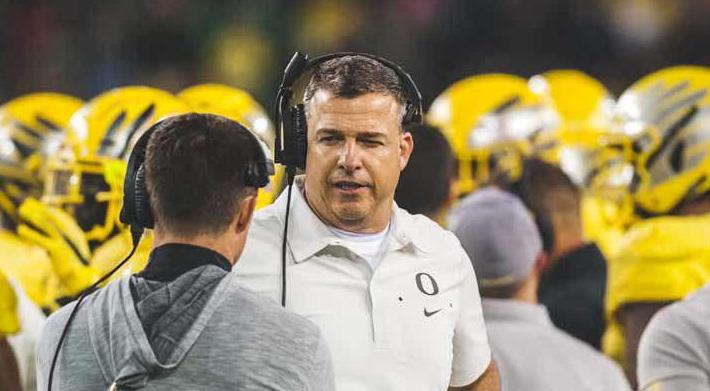
7 minute read
SPORTS
91 UO ATHLETES HAVE 91 UO ATHLETES HAVE TESTED POSITIVE FOR TESTED POSITIVE FOR COVID-19 SINCE JULY COVID-19 SINCE JULY
From mid-July to early March, swaths of student-athletes tested positive for COVID-19 while the university blanketed the info with a cloud of ambiguity.
BY SHANE HOFFMANN • TWITTER @SHANE_HOFFMANN
Ducks head coach Mario Cristobal on the sideline during a timeout. Oregon Ducks Football takes on the Colorado Buffaloes at Autzen Stadium in Eugene, Ore. on Oct. 11, 2019. (DL Young/Emerald)
Note: This story originally appeared in The Oregonian/OregonLive on May 2.
Oregon Ducks football coach Mario Cristobal and his staff often err on the side of ambiguity when handling injuries within the program, keeping exact diagnoses close to the vest. Many programs across the country do the same. But this past season brought an added wrinkle across the UO athletic department: the suppression of information surrounding COVID-19 cases among student-athletes.
As college football forged on last fall despite the pandemic, swaths of athletes tested positive for COVID-19 around the country. In the Pac-12, programs had to opt out of games on a near-weekly basis due to outbreaks. Most schools in the conference announced when players had tested positive or would miss time due to illness. Oregon, however, chose not to report positive cases among athletes to the public. The only time the athletic department announced a positive case was when five football players tested positive on Oct. 24, results that were deemed false positives days later.
Data obtained by The Oregonian/ OregonLive through a public records request show 91 out of the university’s 520 student-athletes tested positive for COVID-19 between July 17, 2020, and March 2 of this year. According to the university’s latest enrollment numbers, 17.5% of student-athletes have tested positive, compared with 8% of students overall, though student-athletes are required to get tested frequently, while other students are not.
Over the course of that same window, Oregon State recorded 66 positive tests among studentathletes. Since UCLA began testing on June 22, it has recorded 93 positive tests. Elsewhere in the conference, Washington State had recorded well over 100 by mid-November and Washington had more than 80 through the month of December.
The records from UO did not specify the athletes’ sport or team but do indicate spikes in cases that corresponded with the start of the football season, as well as the men’s and women’s basketball teams’ pauses in activity in January and February.
Although the Pac-12's football season didn’t commence until November, Gov. Kate Brown cleared both Oregon and Oregon State to begin practicing on Sept. 17. In the following 13 days, 15 student-athletes at UO tested positive for COVID-19.
Forty-two of the athletes’ reported positives came between July 17 and Jan. 2, when the UO football season ended, while 49 occurred in the next two months, from Jan. 3 to March 2. Similarly, a majority of UO’s overall student cases came in January and the months following.
When the men’s and women’s basketball programs paused all team activities multiple times in January, it was labeled “due to COVID-19 protocols.” The men’s program experienced a pause of all team activities on Jan. 12 for 10 days and then paused again on Jan. 26 — the same day that eight of the positive tests were recorded. Three more were reported over the next three days. The women’s program was paused on Jan 29. Six cases were reported between Jan. 29 and Feb. 5.
January saw the most positive cases among UO athletes, with 31, followed by 19 in February, 16 in September and 11 in October.
This is the first time the university has reported this data, previously declining media requests while citing privacy laws such as HIPAA. The Health Insurance Portability and Accountability Act, and FERPA, the Family Educational Rights and Privacy Act.
FERPA and HIPAA do prohibit schools from disclosing information that could potentially harm or identify individuals, but do not prevent the university from disclosing aggregate numbers to the public.
“I can say confidently that denying access to such data doesn’t serve public interest,” said attorney Gunita Singh, legal fellow with the Reporters Committee for Freedom of the Press. “FERPA and HIPAA should absolutely not be used to withhold de-identified, aggregate data about the toll of the virus, especially at a time like this when we are by no means out of the woods.”
Singh added: “I do think there is a degree of short-sightedness when these laws are overapplied, because it is to everybody’s detriment. The public and the news media have a right to see the data, understand the trends, understand the risks involved with physically heading back to school.”
UO does keep a regularly updated database of all student cases at the university.
It isn’t completely clear why UO has now released COVID numbers among its athletes after previously refusing to do so. UO spokeswoman Kay Jarvis told The Oregonian/OregonLive that when testing first began last summer, there were so few students being tested, and so few positive results, that the university was not able to release data because of FERPA. Jarvis wrote that some requests “were made before records were available.” When asked in early December if there had been any cases within the football program, UO athletic department spokesman Jimmy Stanton did not answer, saying via email that all data is reported to Lane County Public Health and the UO campus in the aggregate only and was not available to the public. He added, “data on individual student-athlete testing results is protected personal health information and not released.”
A New York Times investigation published Dec. 11 reported at least 6,629 coronavirus cases in athletic departments around the country. Nine Pac-12 schools provided complete data, and two — Colorado and Arizona State — contributed “limited” data. Oregon was the only school in the conference to provide no data. Oregon was among 19 schools of the 130 surveyed that did not provide the information.
A New York Times spokeswoman told The Oregonian/OregonLive via email that UO denied requests for data and that the newspaper subsequently filed an open records request. The university responded by saying it did not have records about cases in the athletic department, and that any records it did have would be exempt due to privacy.
Many of the university’s Pac-12 peers have made complete logs of aggregate testing numbers among athletic departments available to the public. Several schools, including UCLA, provide the number of studentathletes tested, along with the number of active positive cases each week.
Asked why UO differed in its approach, Jarvis wrote: “We respect the privacy of our students, including our student-athletes, and do not believe that the privacy of athletes’ health status is any less worthy of protection than that of any other students or employees on our campus.”
UO did not provide the number of total tests administered to studentathletes or the number of negative results, saying via email that it does not possess those records.
“It’s important that people have the truth, that they know the real data so that they can make decisions about how to live their life,” said Chris Sinclair, the president of the UO faculty union and former president of the faculty senate.
The UO public records office told The Oregonian/OregonLive that all student-athletes were tested upon returning to campus for the first time. After that, the frequency of testing among sports is determined through the sport’s risk of transmission — based on the NCAA definition of high, medium or low risk — and whether a sport is in season.
During football season, the program provided antigen testing six days a week and a weekly polymerase chain reaction test — a method that rapidly creates millions of copies of a specific DNA sample. Football out of season has weekly PCR testing.
Low-risk programs — like beach volleyball, golf and tennis — test only if athletes develop symptoms and 48 hours prior to traveling to a competition, according to the UO public records office. Medium-risk sports like softball and baseball have weekly PCR testing while in season and every other week out of season.






